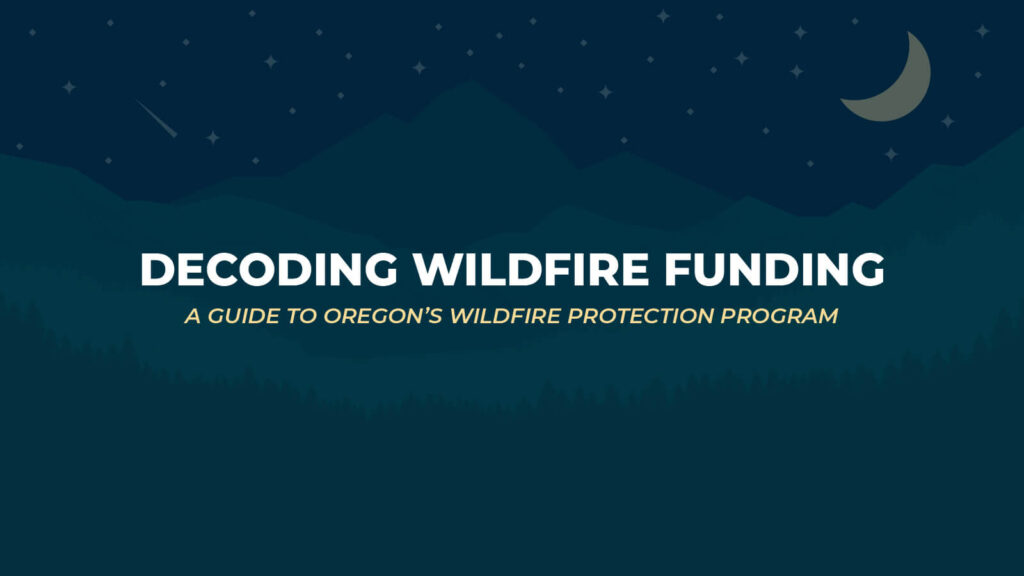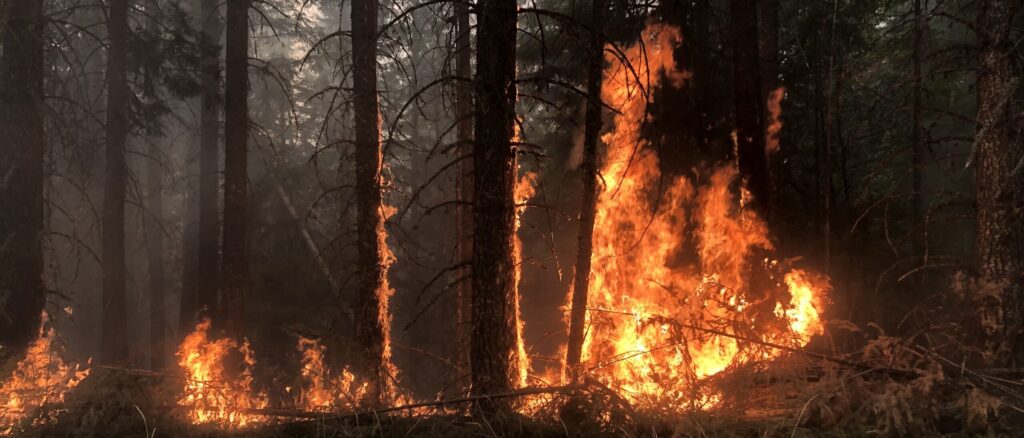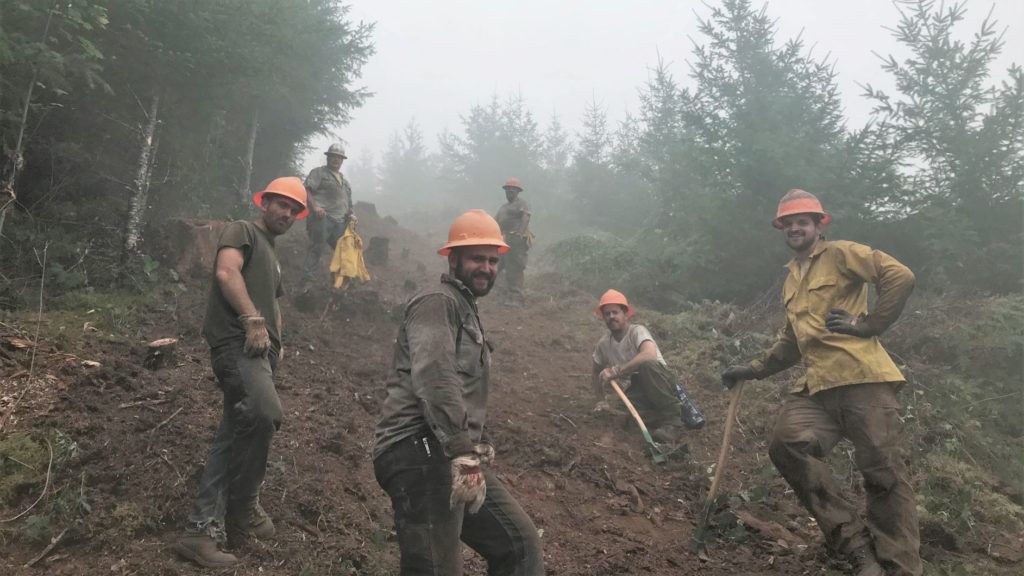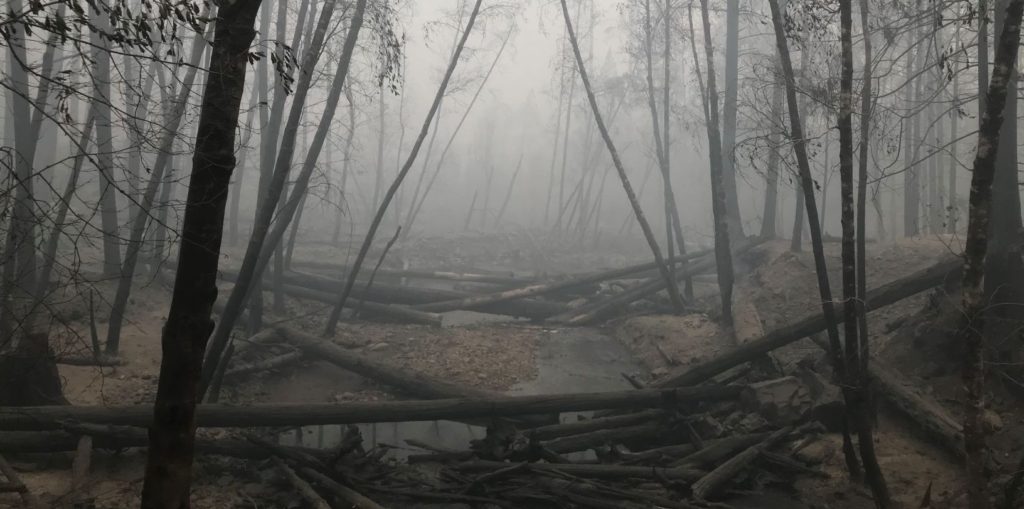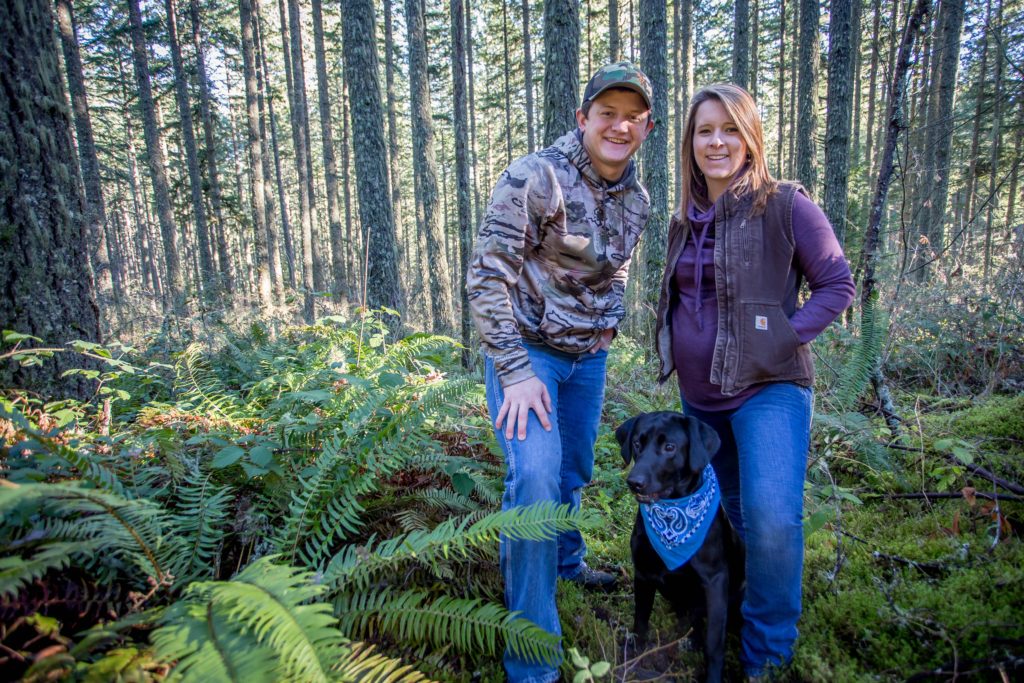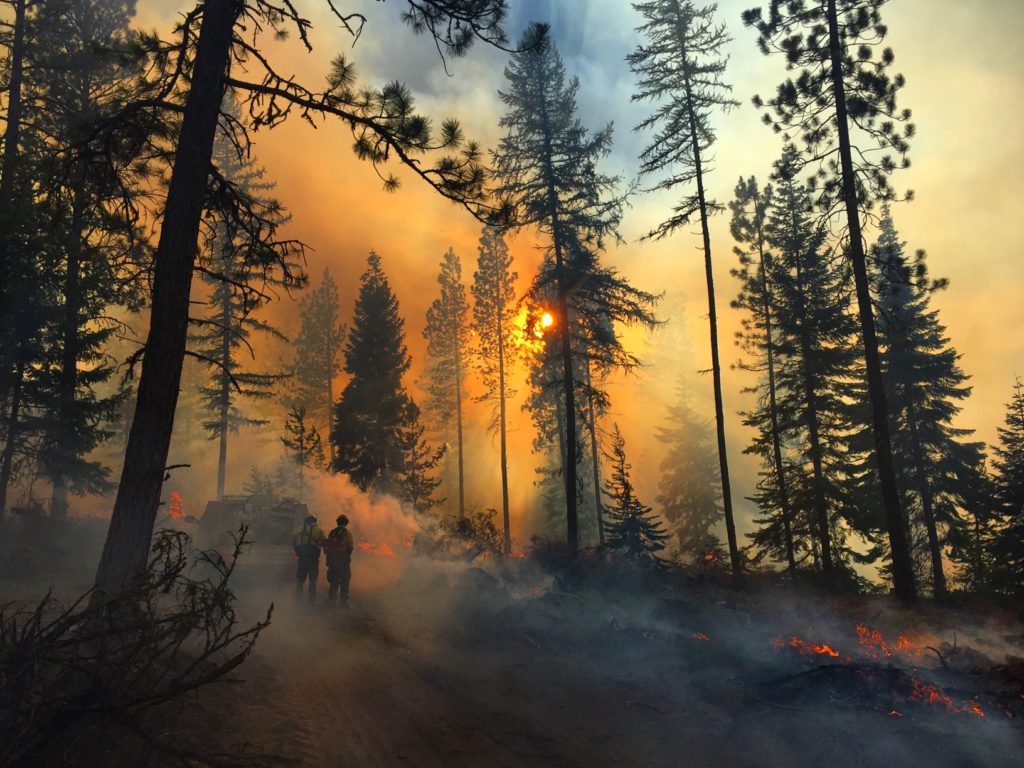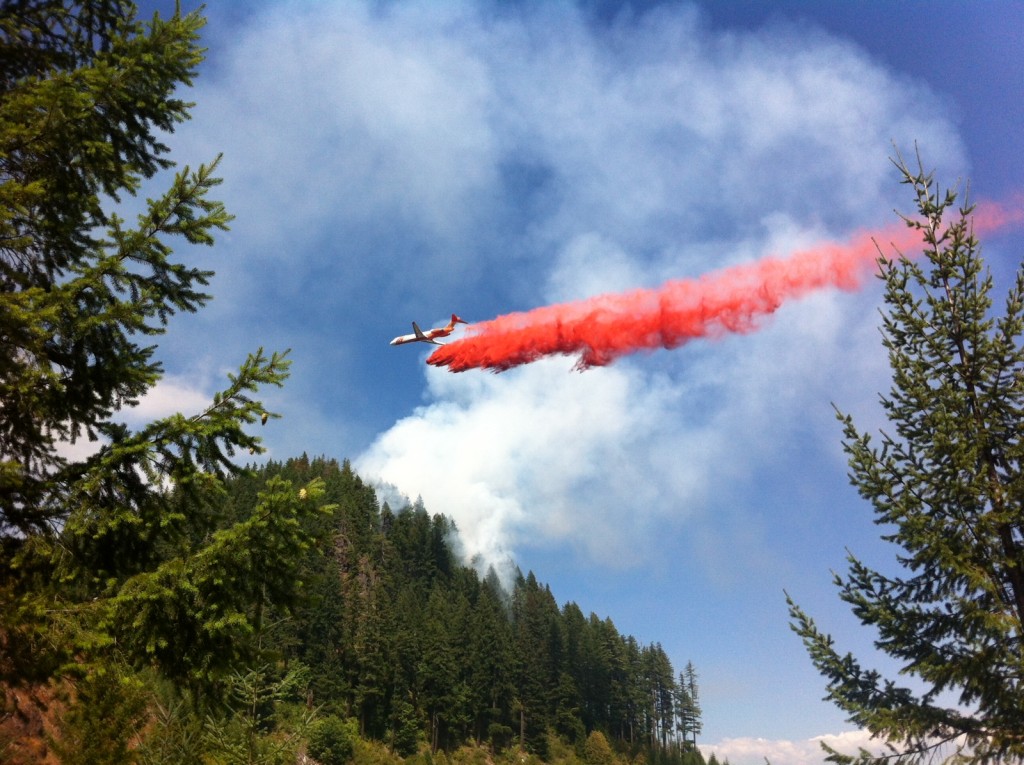In an effort to help policymakers better understand Oregon’s wildfire funding system, today OFIC launched a new explanatory section of its website dedicated to wildfire funding and the current funding crisis. Check it out here!
Fire
Wildfires are an All-Oregonian problem
**This opinion originally appeared in the Portland Tribune
Kyle Williams Feb 16, 2024
It has been frustrating to read the incomplete media coverage on Sen. Elizabeth Steiner’s wildfire funding bill (House Bill 4133). While salacious headlines get clicks, the actual story is less scandalous.
Here’s the less exciting version: the bill comes from a work group I participated in led by Sen. Steiner. It consisted of six different size and type of landowners (conservation, tribal, ranchland, county, and large and small forestland) who directly pay taxes to fund the Oregon Department of Forestry’s (ODF) wildfire fighting costs. The goal was to address an affordability crisis related to the growing costs of wildfire.
We can all agree wildfires are increasingly affecting our health, economy, quality of living and, worse, costing lives and burning whole communities.
And while that’s a huge problem, it’s not one caused by private landowners who help fund ODF’s system. The vast majority (over three-quarters) of fires that put smoke into the air and threaten communities start on federal land, not land protected by ODF. But Oregon’s landowners and ODF spend firefighting money preventing those fires that start on federal land from spreading to private land and communities.Clearly, wildfire is an all-Oregonian problem and needs an all-Oregonian solution.
That was one of the principles of Sen. Steiner’s work group. The goal was to address increased costs from a 2021 bill that directed several million dollars in ODF investment to boost their ability to fight wildfire. That meant those landowners’ taxes went up — more than 40% in some cases. For several ranchers and small forestland owners, that increase threatened to put them out of business.
Oregon’s wildfire funding structure is the most complicated in the nation. In the simplest of terms, the system is funded roughly half by the General Fund (all Oregon taxpayers) and half by rural landowners (forestland, ranchland, etc.) Fortunately, the system itself is also the most effective in the nation — ODF puts out roughly 96% of fires on the land it protects at 10 acres or less.
Sen. Steiner did something no other legislator has done — she invested the time, and pulled in the right experts, to fully understand the system. And then she helped the group develop a fair proposal that worked for everyone involved.
It did two things: slightly increased taxes that landowners pay and redirected them so local dollars will be paying for local firefighters — and it asked the General Fund to pay for ODF’s statewide administrative costs to match how all other state agencies are funded. As a result, all landowner rates — not just large private forestland owners — went down a little (enough to keep folks from going broke) and the General Fund contribution went up a little, partly in recognition that all Oregonians should pitch in a little more to protect our air and communities.
An initial idea would have brought in additional money for the General Fund: asking all property owners (not just those whose land ODF protects) to pay $10 per year. That idea got dropped before the bill was introduced, which means the landowners will need to increase their contribution fill that gap.
Earlier this February, Legislators learned they have $560 million more to work with than anticipated, so asking the General Fund to pay a bit more for statewide services doesn’t seem out of the picture.
Also incomplete in the reporting was the comparison between how much Oregon forestland owners pay for firefighting compared to Washington. It is true that Oregon landowners directly pay more for fire protection than in any other state. It is also true that Washington landowners pay different taxes into their General Fund than in Oregon. So do Oregon landowners — we pay more for family medical leave and pay corporate excise and income taxes that Washington doesn’t pay. When one considers the entire tax burden on the sector instead of only narrowly looking at one part, the contributions in each state are very similar. And Oregon’s contributions may be greater now due to an increase just last year in the Forest Products Harvest Tax as a result of the Private Forest Accord and an increase in fire cost burden resulting from that omnibus wildfire bill passed in 2021.
We hope common sense Oregonians are willing to look beyond the attention-grabbing headlines and listen to the real story, which can be found on the most recent episode of the Forestry Smart Policy podcast, where Sen. Steiner explains the origins and process of the work group.
Kyle Williams of Albany is the director of Forest Protection for the Oregon Forest Industries Council and has more than 20 years of experience working in the fire protection system throughout Oregon on both private and public forestland.
Oregon Forest Protective Association Receives Forestry Appreciation Award from Oregon Society of American Foresters
For Immediate Release
Contact: Andrea Watts, OSAF: 503-224-8046, wattsa@forestry.org
PORTLAND—The Oregon Forest Protective Association (OFPA) has received the Forestry Appreciation Award from the Oregon Society of American Foresters (OSAF). Members of the OFPA accepted the award at the OSAF virtual Annual Meeting on May 13, 2021. This award is presented whenever appropriate to individuals, groups or institutions outside the forestry profession that have contributed significantly to the advancement of forestry in Oregon.
Oregon Forest Protective Association (OFPA) was incorporated in 1910 as the OFFA (Oregon Forest Fire Association), which was changed to Oregon Forest Protective Association in 1958. This system has become known as Oregon’s Complete and Coordinated Fire Protection System, which includes forest protective associations statewide, the Oregon Department of Forestry (ODF), and cooperating agencies. The forest protective associations are made up of forest landowners, both industrial and non-industrial, as well as Bureau of Land Management (BLM) in western Oregon. Three of the associations are operating associations, providing protection for their members and other forest landowners by contract with the State Forester.
“Oregon’s wildland firefighting system is unique in its public/private partnership,” said Kyle Williams, Director of Forest Protection for Oregon Forest & Industries Council. “Forest landowners and forest industry operators and contractors engage on a regular basis with Government firefighting personnel (primarily ODF) to provide enhanced initial attack capability with their own company firefighting equipment and personnel. Loggers, road builders, timber fallers and reforestation contractor crews routinely leave their ‘day jobs’ to do initial attack on fires in successful efforts that extinguish fires early, keep resource loss to a minimum and provide special skills and equipment to build fire line, open roads, fall burning snags, extinguish hot spots and provide mop-up services.”
During the 2020 fire season, the entirety of western Oregon, from the Oregon-California border north to nearly the Columbia River, was enveloped by fire. Five fires in the Cascades burned over 100,000 acres each, moving into Oregon’s top 20 wildfires by size since 1900. All told, over a million acres burned in total in Oregon including losses on U.S. Forest Service-protected (USFS) lands. Roughly 400,000+ acres burned on the private, state, and local government lands fully protected by ODF or fire protective associations, with another 100,000+ acres burned on western BLM lands for which ODF and the associations have initial attack responsibility.
“When the Labor Day fires blew up and quickly exhausted all government agency resources, that private partnership became critical to the efforts to protect homes and communities,” explained Williams. “Private timber industry employees and landowners immediately engaged on the hundreds of miles of fire line throughout the state—those woods workers who would normally be managing an operation, laying out a unit, running a log-loading shovel, building road with an excavator, setting chokers or thinning young forest stands—hauled over 350 pieces of equipment and deployed over 650 trained personnel to the fires and pitched in side by side with ODF and USFS fire fighters in what became an incredible example of the complete and coordinated system.”
Oregon’s complete and coordinated system, although sorely tried and tested, delivered in the end.
OSAF and its 15 local chapters represent all segments the forestry profession within the state. The society includes public and private practitioners, researchers, administrators, educators, and forestry students. Its mission is to advance the science, education, technology, and practice of forestry; to enhance the competency of its members; to establish professional excellence; and to use the knowledge, skills, and conservation ethics of the profession to ensure the continued health and use of forest ecosystems and the present and future availability of forest resources to benefit society.
###
Opinion: Tax policy should respect stability of Oregon logging businesses
By: Todd Payne | The Oregonian | March 10, 2021
Payne is chief executive of Seneca Family of Companies and chairman of the board for the Oregon Forest and Industries Council.
**This opinion originally appeared in The Oregonian.
The March 2 story “Oregon’s logging industry says it can’t afford new taxes” misunderstands the market complexities of our state’s most iconic industry. The severance tax proposed by HB 2379 would not be paid by mills making short-term profits on high lumber prices driven by homeowner remodeling demands during stay-at-home orders. It would be paid by 65,000 private forestland owners in Oregon who collectively just lost over 400,000 acres to wildfires.
I can honestly say this is the worst time to increase taxes on private landowners. According to our calculations, the tax would be an 800% increase in taxes on harvested timber, which is completely untenable. Taxes are permanent. Blips in short run markets are not. Oregonians expect thoughtful policy decisions that respect the stability of family businesses, not attempts to tax them out of existence.
Private forestland owners and manufacturers make Oregon the number one national producer of lumber, and we have more trees today than we did 100 years ago. Seneca is one of Oregon’s oldest, home-grown, family-run forest products companies. We employ 470, manage 170,000 acres in seven counties and operate four sawmills and a co-generation facility that provides clean, renewable energy to 13,000 homes in Eugene. We’ve survived through smart innovation, experienced risk calculations and a grit and endurance that only come from loving what we do.
We are one of few remaining Oregon companies that own forestland and sawmills, giving us expertise on market dynamics between logs and lumber prices. The story focused on lumber prices, but that’s only one part of the equation. Log prices and lumber prices are often disconnected. Because one temporarily goes up does not mean the whole supply chain benefits. More important is long-term stability. Unlike farmers who harvest their crop annually, we invest in cultivating seedlings for 40+ years before we see a return – provided those trees aren’t lost to fire, insects, disease, or ice.
Our industry and its 60,000 Oregon employees depend on the health and vitality of both the mills and the forests that supply them. Unfortunately, the Labor Day fires disrupted that balance, and in the coming years our mills will undeniably face a shortage of timber. In addition to wildfire losses, the state is proposing a 70-year management plan that makes almost 60% of state-owned forests off-limits to harvest. We anticipate upcoming regulatory changeswill further decrease harvest.
Over the last few years, the Oregon Legislature has increased the tax burden on businesses by a whopping 41%, according to a report for Oregon Business and Industry. An additional 800% increase in taxes on harvested timber could make it economically unfeasible to maintain forestland as it would be layered on top of existing property taxes, income taxes, payroll taxes, the new Corporate Activity Tax, plus assessments for fire suppression.
Today, timber is correctly taxed as a crop, but forests are more than just crops – they provide many environmental and social benefits. That’s why our tax and land use systems work together to prevent incentives to convert forestland to other uses. While trees grow, they provide water filtration, air purification, carbon capture and storage, wildlife habitat, and recreation. When trees are harvested, they create family-wage jobs and the only reliable, renewable source of carbon-neutral building materials.
Our Legislature should help businesses struggling through the pandemic, not increase their taxes. We should focus on restoring hundreds of thousands of acres of burned forests back to healthy, thriving forests that are less likely to burn – not taxing the people doing that work.
After the fires, timber industry faces ‘generational’ losses and longer-term supply questions
By Ted Sickinger | The Oregonian | Nov 22, 2020
**This story originally appeared in The Oregonian
Rick McKay’s logging crew was off for Labor Day weekend when the Lionshead fire blew through its job site just above Breitenbush Hot Springs.
When crew members cut their way back in two weeks later, what they found was a scorched-earth patch of the fire that had consumed or damaged most of the equipment on site.
A grader purchased in January. Toast. Two log processors and a log loader. An excavator. A roller. Two trailers. A pickup/fire engine and a water tanker.
Some is insured, McKay said, but like most loggers, a bunch isn’t. He’s still trying to figure what’s salvageable.
“It was a big hit,” he said, estimating the value at $1 million. “Replacing that equipment isn’t easy either…I’m almost 60.”
Oregon’s timber industry, made up of companies small and large, is still counting its losses. Nobody has a credible number yet. It’s huge. And equipment losses are the least of it.
One industry estimate is that the fires burned or damaged trees that might have produced 15 billion board feet of timber. Only a portion of that was in areas open to logging, but it’s nearly four times what Oregon’s industry harvests each year.
The fires burned through an unusually high concentration of private land, most of it industrial forestland, and hit a subset of companies particularly hard based on where they own land and operate. They also scorched federal forests, including big sections being managed for timber production.
Logging and hauling contractors, many of them family run outfits built over generations, took a heavy hit, not only in burned equipment, but idled operations, lost payroll and other costs.
The ripple effects will spread through the sector. Pressure will increase to boost logging on public lands to make up for the lost supply. And controversy will follow.
Meanwhile, companies are scrambling to salvage what they can in the two- to three-year window when the dead wood is still merchantable. Then comes rehabbing the land. When the labor and seedlings are available, that will be a multi-year process involving major outlays.
Freres Lumber, which operates five mills in the Santiam Canyon, saw about 40% of its land holdings in the basin burned.
“We’ve lost time, we’ve lost 30 years of growth and we’ll never be able to get that back again,” said Tyler Freres, vice president of sales. “And all those lands need to be rehabbed to start growing trees for future generations of our company. It’s a big hit for generations.”
Heavy private losses
More than 1 million acres were within the perimeter of the fires that blew up over Labor Day, an area equivalent to 3% of Oregon’s forestland. Almost all of it was on the west side, where the industry is clustered, and nearly 40% were industrial or other private forestlands.
That’s unusual. The U.S. Forest Service and Bureau of Land Management own 60% of Oregon’s forestland, and over the last decade, some 86% of acres burned in Oregon’s seasonal wildfires were on federal land.
Experts say that’s a function of fire suppression tactics, as fires are sometimes left to burn if they don’t threaten lives and structures, as well as conditions on the land. The industry’s mantra has long been that those forests – with a buildup of highly flammable downed limbs and dead vegetation — should be more heavily managed and logged to reduce fire risk and generate more supply.
Among private landowners, Weyerhaeuser took the biggest hit. As a publicly traded company, it reported its losses in securities filings for the third quarter. It estimated the fires touched 125,000 acres of its land, and it booked an $80 million loss for timber that will not be able to be salvaged. It’s a big number, but not material for a company that owns 11 million acres of timber in the United States alone and recorded $2.1 billion in sales that quarter.
Most of the companies that lost timber in the fires are much smaller, private, and reluctant to share specific figures. The Oregon Forest Resources Institute is undertaking a study of the industry losses from the fire, but that won’t be out until May.
Freres Lumber’s operations are heavily concentrated in the Santiam Canyon, where it owns some 19,000 acres of industrial forest land and operates five mills that employ about 400.
The company typically gets about 15% of its log supply off its own lands. Tyler Freres says the company’s initial estimate is that about 7,500 acres of its land was impacted, including timber with a value of about $50 million at current delivered prices. The company anticipates it will cost between $7 million and $9 million to replant over a period of time.https://www.youtube.com/embed/_6Wfsib9Bgg?feature=oembed
Casey Roscoe, a senior vice president at Seneca Sawmill, said the company had 640 acres within the Holiday Farm fire and 10,000 acres within the Archie Creek fire and is still assessing damages. The losses will be in the tens of millions, she estimated.
Wood products companies say they have two or perhaps three years to salvage trees impacted by the fires before rot, insect infestation and blowdown render them unusable. During that period, mills are likely to have a surplus of wood coming in, albeit black logs. That timber is generally worth 25% less than unburned logs and is more difficult to process.
Longer term, say four to 10 years out, the question of supply looms larger.
Federal losses
Some 60% of the acreage burned in the fires was on federal lands, including areas of the Mt. Hood, Willamette, Siuslaw, Fremont-Winema, Umpqua and Rogue-Siskiyou national forests. A significant chunk was in areas the Forest Service manages for timber supply.
According to a preliminary Forest Service analysis, the fires in Oregon burned through stands covered by some 28 federal logging contracts that had already been awarded. Those contracts, which included 172 million board feet of timber, typically run from three to seven years, and were in various stages of completion.
Another 15 planned sales totaling some 90 million board feet also were burned to varying degrees and put on hold. And the fires burned in “planning areas” slated for future contracts that hold more than 175 million board feet of potential harvest.
Those figures only count contracts on Forest Service land – not the other large federal player, the Bureau of Land Management.
Matt Hill, executive director of the Douglas Timber Operators trade association, said the BLM initially said about 22 million board feet of the Roseburg District’s planned 2021 timber program were affected, though the total land base impacted is much larger.
In general, the Forest Service and BLM designate about 80% of the forests they manage as reserves set aside for old growth habitat, and about 20% is made available for potential logging. Though the federal harvest has declined precipitously from decades ago, is still an important component of many timber companies’ supply.
According to Andy Geissler, federal timber program manager at the American Forest Resource Council, the footprint of the fires on the Mt. Hood National Forest and the Detroit district of the Willamette National Forest was particularly concentrated in areas designated for timber production.
“Their future timber program is very uncertain,” he said. “If the timber program for any particular forest is reduced by 40% to 50% annually, there are ripple effects beyond those regular purchasers off those forests and it will be felt around the region.”
It’s unclear how much post-fire logging will be allowed in existing contract areas and whether the Forest Service and BLM will provide replacement contracts. Over the next decade, that debate will expand to cover the Forest Service and BLM’s unburned, green timber programs.
Given the size of the federal land base, experts say pressure will mount on federal managers to replace the lost harvest base and even make up the volume from industry losses on private land. And that will tee up opposition from conservation groups
“The bottom-line takeaway is that we’re moving a lot of wood that’s wasn’t ready to get moved very quickly, and we lost private inventory that would have been spaced out over the next few decades,” said Hill of the timber trade group.
“When that is gone and it’s not available five or ten years from now, who fills that gap?”
Logger losses
The Associated Oregon Loggers estimates that the fires’ costs to logging contractors will ultimately exceed $100 million.
It’s big number. Another guesstimate. But logging equipment doesn’t go home at night, and that figure includes $43 million in burned equipment owned by about 30 separate companies, including 112 pieces of logging, hauling and road building machinery.
As with McKay, who says he lost about $1 million worth of equipment, much of what was lost was uninsured or underinsured.
The association says idled operations cost another $22 million in lost payroll payments as the industry was shut down anywhere from two to six weeks, and still hasn’t resumed operations in many burned areas. Other costs included the debt payments on their idled machinery, the cost to move it to other jobs and replacement premiums on lost equipment due to supply shortages.
“A few companies will close their doors, while others will operate at reduced capacity as they gradually replace what they lost,” said Rex Storm, executive vice president of the trade association. “It’ll rebuild and rebound, but it will take some time, and it comes at a high cost to their businesses, to their productivity and to their workforce.”
Chuck Goode, a logging and hauling contractor based in Silverton, counts himself lucky. He moved his logging equipment off a job north of Detroit Lake two weeks before the fires, so nothing burned.
For now, he has put all of the jobs he had lined up for winter on hold while he helps Freres salvage log on their burned land — until rain and snow put a stop to that.
It’s dirtier, costlier and more dangerous work than normal. Charred bark dulls blades faster. Yields are lower. And with burned out roots, no needles, and brittle wood, trees fall faster and break apart, occasionally ricocheting back on the harvester, as happened three times in Goode’s first week on the job.
“My destiny is I’m going to be logging burnt timber,” Goode said. “At some point it’s a loss to log it, then I don’t know what’s going to happen.”
Rehab and replanting
Rehabilitating and replanting private forestlands will be a years-long undertaking, one initially limited by the supply of seedlings and labor to complete the work.
Mike Cloughesy, director of forestry at the Oregon Forest Resources Institute, says rehab costs on a very young stand — clearing the ground, rehabbing soil and planting seedlings — might be $400 to $500 an acre. Getting into stands over 20 years, it might be as high as $1,500 an acre as most of the biomass is still there, and needs to be cut, piled, chipped or burned. In older stands, the higher salvage value of the trees may turn a profit.
Kathy LeCompte, the co-owner of Brooks Tree Farm in Salem, said the seedlings needed to replant are grown for specific elevation zones so they are genetically acclimated. She says it’s typically a two- to three-year process to grow a seedling that timber companies would plant, and that the nursery industry was already experiencing a seed shortage before the fires.
“Of course, no one knew to go collect seed in those areas two years ago and grow 50 million seedlings,” she said. “If we didn’t have the seed planted in 2019, the people who got burned out don’t have anything to work from.”
Timber companies maintain their own seed banks, and many rushed into the seedling market as the fires were burning to secure supplies.
“If we had several million seedlings, that would be great, but we don’t have the labor to put them in the ground,” said Peter Sikora, chief executive of Springfield-based Giustina Resources.
Sikora said Giustina lost several generations of trees on its land in the Holiday Farm fire. At this point the company is concentrating on salvaging trees at higher elevations and working its way down. The company had extra seed in cold storage, and while it doesn’t typically replant using seed, it’s trying this year.
“We hope we get some viable growth,” he said. “I don’t know how that’s going to work at some of our higher elevations. It’s an experiment.”
Guest View: Practical solutions must win the day
By Garrett Yarbrough | November 7, 2020 | Register-Guard
**This opinion originally appeared in the Register-Guard.
Dylan Plummer’s column misrepresents not only the 2020 wildfire season but also the past decade of wildfires in Oregon. Any reasonable conversation about wildfire should not cherry pick one fire and one study to make sweeping conclusions about cause and effect, and readers should be skeptical of those who attempt to do so. Moreover, structuring competing, divisive narratives assigning blame rather than seeking solutions won’t help Oregonians recover or rebuild after the traumatic and heartbreaking loss over the last month.
The 2020 wildfire season is unlike any we’ve seen in the last 100 years — and no single cause exists. The east-wind-fueled weather event on Labor Day was extreme and unprecedented in our lifetimes, creating a fire situation that shocked seasoned firefighters and fire experts. In such an extreme event, any land would have burned, managed or not. These fires did not discriminate between young and old forests. Over a million acres burned across all ownership types — federal, state, tribal and private. In such an extreme event, fire perimeters almost perfectly mirror ownership distribution in the state: roughly 60% federally owned and 40% state/privately owned.
No one was left unscathed.
Three elements control wildfire: weather, fuel and topography. The only one we can manage is fuel. Proven, science-based forest management tools like logging, thinning and controlled burns reduce excessive vegetation that fuel catastrophic wildfires.
Outside of the extreme example of 2020, in the past decade 86% of the acres burned in Oregon were on federal land. Excessive buildup of fuels from decades of poor management have left federal forests overstocked with disease- and insect-ridden trees and standing dead timber — extremely dangerous conditions with catastrophic results when lightning strikes. This buildup creates “ladder fuels” allowing fire to torch up to tree crowns where embers catch on the wind and spread fire for miles.
Fires on managed forestland are easier to put out because fuels are reduced through harvest, lands are replanted after fire, access is maintained through roads and fires are aggressively, but safely, put out. Young plantations may burn thoroughly and completely, but it is in these areas that firefighters are often able to gain control of a wildfire and stop it from spreading. I was on the Holiday Farm Fire, and after personally scouting miles of decommissioned and degraded federal road systems for fire line, it was evident that catching and holding fire on federal ground would be more difficult than on private land.
Since 2000, 15 of the 16 megafires in Oregon started on federally managed lands — many of them then spread to private and state lands where they were put out because of road access and better fuel management. In 2020, Oregon saw 17 large fires on the landscape. Over half of them, including many of the most destructive fires like the Beachie Creek, Archie Creek and Riverside fires, likely originated on federally managed lands and spread to other ownerships.
These are simply the facts that help us move away from assigning blame and instead to uniting around solutions. Now is the time for practical solutions and actions to put out dangerous fires, protect against future catastrophic fires, and restore and rebuild communities.
Instead of assigning blame, our sector prefers to get to work. Every year Oregon’s timber industry provides millions of dollars of equipment and manpower to battle fires to save people and property, at the risk of their own lives. 2020 required even more — with state and federal firefighting resources spread thin, private foresters and loggers filled the gap. Private forest landowners and operators were and still are on the front lines supporting federal and state firefighting efforts, with more than 650 employees and over 350 pieces of privately owned equipment. In many cases, private resources were the only crews on significant portions of the 2020 fires. Some of those men and women had lost their own homes and still reported to the fire line the following day to help save surrounding communities.
And now that rains and firefighting efforts have slowed the spread of the fires, the forest sector is pivoting its focus to the future — restoration and regeneration of Oregon’s forests — a feat that will likely require over 100 million tree seedlings. Restoring hundreds of thousands of acres of damaged forest back to healthy, thriving forests is the best way to prevent dead and dying trees from re-burning in the future (dead trees create future fuel for wildfires) and maximize the forest’s ability to capture and store carbon.
That’s what we’ll be focused on in the coming months — solutions that help Oregonians recover. We invite others to join us.
Garrett Yarbrough is a Lane County forester and firefighter.
Timber Companies Step Up to Fight Archie Creek Fire
By Evita Garza | KEZI | Sept 18, 2020
**This story originally appeared on KEZI
ROSEBURG, Ore. — Local timber companies are stepping up to help firefighters as they battle the Archie Creek Fire.
Lone Rock Resources, based in Roseburg, sent 50 of their operational employees to fight the fire when it started last Tuesday.
Staff said they’ve also sent more than 20 pieces of their own equipment to help firefighters secure fire lines and cool hotspots.
Company president Toby Luther said many of their employees had some fire training before they were sent out.
“In situations like this when the state and federal resources are spread so thin, if we didn’t have those industrial resources, we would have so many more losses in those communities,” he said.
Luther said he is proud of their employees for the work they’ve done so far. With limited resources around the state, he said they will be fighting this fire as long as they’re needed to.
“Ten of our own employees had their families evacuated,” he said. “So, in some cases, guys were out fighting fires during the day and going home and helping their neighbors protect their homes at night.”
Luther said there are multiple timber companies working alongside them, including Seneca Joes Timber Company and Roseburg Forest Products.
PROFESSIONAL FORESTERS FILE INITIATIVES TO PROTECT PROVEN FORESTRY PRACTICES AND REDUCE WILDFIRE RISK
FOR IMMEDIATE RELEASE
Contact: Sara Duncan
Phone: 503-828-2373
Email: sarad@gallatin.com
PROFESSIONAL FORESTERS FILE INITIATIVES TO PROTECT PROVEN FORESTRY PRACTICES AND REDUCE WILDFIRE RISK
Three-Part Plan Safeguards Landowner Rights from Risky Anti-Forestry Management Proposals
[SALEM, November 5, 2019] – Professional foresters and forest landowners filed a package of citizen initiatives for the November 2020 General Election aimed at protecting the rights and proven forestry practices being put at-risk from radical anti-forestry ballot initiatives currently being pursued by environmental extremists.
“Oregon has some of the nation’s strongest environmental protections to ensure clean drinking water, require the replanting of millions of new trees and that keep our private forests and environment safe from catastrophic wildfires,” said Jim James, a chief petitioner of the three citizen initiatives and a Foster-based professional forester.
“But risky, radical proposals for the 2020 ballot would end proven forestry practices, preventing millions of new seedlings from growing into healthy forests and creating greater risks of dangerous fires that destroy our environment and pollute our air. We are committed to protecting what works and doing everything we can to defeat these risky, radical proposals.”
The initiatives filed today protect proven forestry practices and ensure the rights of forest landowners to responsibly manage their forests for both private and public benefit.
The Healthy Forests, Wildfire Reduction Plan includes:
- The Oregon Forest Science Standards Act: Requires forest management be guided by peer-reviewed science;
- The Forestry Oversight Improvement Act: Adds forestry experts to Oregon’s State Board of Forestry; and
- The Fair and Just Compensation Act: Compensates property owners when government activities unfairly destroy or devalue their property.
According to statistics from the Oregon Department of Forestry, in the past 10 years, 80 percent of forest acres burned by uncontrolled wildfire in Oregon have occurred on neglected, unmanaged federal forests. Although Oregon’s 2019 wildfire season remained relatively calm, over the past decade, more than 2.5 million acres of federal forestland has burned in Oregon, a direct result of years-long litigation over forest management on federal lands, even for health and disease purposes.
“Professional forestry is working on private forest lands in Oregon – for the environment, for people and for wildlife. When we protect the rights of Oregon forest landowners, we reduce the risk of catastrophic fires that destroy our environment and pollute our air. When we protect the rights of forest landowners, we ensure millions of newly replanted trees can grow and carbon pollution is pulled from the air,” said James.
###
In Cap-and-Trade Considerations, Oregon Policy-Makers Should Include Reductions for Federal Forest Fire Smoke Carbon Emissions
| FOR IMMEDIATE RELEASE
August 21, 2018 |
Sara Duncan 503-586-1246
Oregon Forest & Industries Council |
In Cap-and-Trade Considerations, Oregon Policy-Makers Should Include Reductions for Federal Forest Fire Smoke Carbon Emissions
On Wednesday, August 22, hundreds of policy-makers will gather in Lincoln City for the annual Oregon Coastal Caucus Economic Summit to discuss carbon cap-and-trade mechanisms and ways to reduce Oregon’s carbon footprint.
“Solutions to decrease unchecked wildfires and increase the production of sustainable wood products in our federal forests must be part of the dialogue of Oregon’s cap-and-trade program,” said Kristina McNitt, Oregon Forest & Industries Council President. “Rampant megafires in federal forests have catastrophic consequences for our safety, health, communities, and economy. Private forestland owners already contribute sizable solutions to climate change by managing forests for fire resiliency and sustainably producing renewable wood products that store carbon for the entire life of the product. Federal forests should do the same.”
Last summer, more than 7,600 people were evacuated from their homes. Oregonians suffered unhealthy air quality and emergency-room visits spiked. The cancellations of Oregon Shakespeare Festival performances, the Sisters Folk Festival, and Cycle Oregon cost our state millions in tourism dollars.
Of the more than 700,000 acres that burned in Oregon last fire season – roughly the size of Rhode Island – an equal number of fires started in federal and private forests, but about 96 percent of the acres burned were in federal forests. This summer, over 210,000 timbered acres have already burned – an area larger than Portland, Eugene and Seattle combined – and roughly 90 percent is in federal forests. Since 2008, nearly 80 percent of burned acres in Oregon were in federal forests.
“There’s a better way to do this,” said Jim James, Executive Director for the Oregon Small Woodlands Association. “Oregon policy-makers can do something to improve the health and economic vitality of all Oregonians, reduce forest fires, and mitigate climate change: take the position of the International Panel on Climate Change and encourage the use of Oregon-grown wood from federal forests.”
In 2007 and 2008, the International Panel on Climate Change concluded that in “the long term, a sustainable forest management strategy aimed at maintaining or increasing forest carbon stocks, while producing an annual sustained yield of timber, fiber or energy from the forest, will generate the largest sustained mitigation benefit.”
Of the roughly 30 million acres of forestland in Oregon, about 60 percent of it is federally-owned, and roughly 34 percent of it is privately owned (the remainder is tribal and state land). Conversely, 75 percent of Oregon’s timber harvest comes from that private forestland (and only 15 percent from federal land), making Oregon the number one producer of softwood lumber and plywood in the U.S. Producing renewable, environmentally-friendly products helps the planet: trees literally use sunlight to capture carbon dioxide (a primary greenhouse gas) from the air and turn it into sustainable building products.
In 1971, Oregon pioneered forest regulations and today observes some of the strictest environmental protections in the nation, including mandatory reforestation after harvest. For every tree that is harvested in Oregon, four are planted in its place. Notably, reforestation after fire is not required, but nearly all private forests are rehabilitated after fire and replanted. Federal forests mostly remain charred.
“When our forests go up in flames, decades of carbon sequestration and storage goes with it,” said McNitt. “We can either breathe that carbon into our lungs as smoke, or we can store that carbon in renewable, sustainable wood products and plant trees to re-start that carbon cycle. We encourage our policy-makers to support wood products to meet Oregon’s climate goals.”
The Oregon Forest & Industries Council is a trade association representing more than 50 Oregon forestland owners and forest products manufacturers. Our members combine sustainable forest management practices with the latest science and technology to continuously improve the environmental, social and economic value of healthy working forests. We protect and manage more than 5 million acres of Oregon forestlands, employ nearly 60,000 Oregonians, and make Oregon the nation’s largest state producer of softwood and plywood. For more information, go to ofic.com.
The Oregon Small Woodlands Association is a member-based association that represents over 3000 small woodland owners in Oregon. For over 50 years OSWA has helped to serve needs unique to small woodland owners. OSWA focuses on fostering peer-to-peer communication between landowners, providing support for legislative and regulatory challenges, and cultivating partnerships to address and solve common problems. For more information, visit oswa.org.
Preparing for Oregon Wildfire: Three Million Acres Burned Since 2012
The last few summers in Oregon have been hot and dry. In fact, for some parts of the state, 2015 was the third consecutive year of drought. In March, the National Weather Service announced that everything west of the Cascade Mountains is clear of drought for the first time since 2013. Those hot and dry conditions have resulted in staggering statistics for the past four fire seasons: wildfires have burned over three million acres in Oregon since 2012. Those are devastating numbers – wildfires threaten lives, destroy homes and damage forests and wildlife habitat.
A worsening “new normal” for fire season begs the question of whether climate change is contributing to an increase in wildfires and how wildfires contribute to greenhouse gas emissions. Both of those questions are extremely difficult for scientists to answer, but we do know that wildfires emit significant amounts of carbon dioxide. As trees grow, they absorb carbon dioxide out of the atmosphere, releasing the oxygen while locking the carbon away in the body of the tree – about half of a tree’s weight is stored carbon. Wildfires release that stored carbon through combustion.
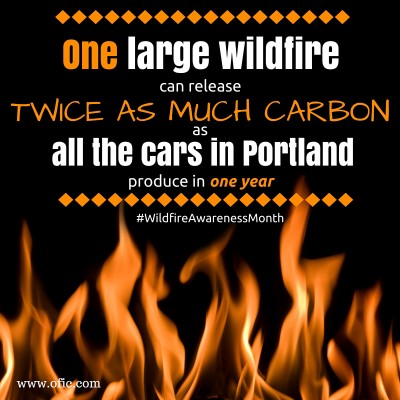 The amount released varies considerably from year to year and fire to fire depending on geography, tree species, and myriad other factors. One study found that one large Oregon wildfire released twice as much carbon as all the cars in the Portland metro region produce in a year. It’s estimated that the recent Fort McMurray fire in Canada– which has to-date burned about one-third the acreage burned in Oregon in the last four years — has emitted between 35 and 85 million tons of carbon dioxide equivalents. That’s equivalent to emissions from 10 to 25 million homes’ energy use for one year.
The amount released varies considerably from year to year and fire to fire depending on geography, tree species, and myriad other factors. One study found that one large Oregon wildfire released twice as much carbon as all the cars in the Portland metro region produce in a year. It’s estimated that the recent Fort McMurray fire in Canada– which has to-date burned about one-third the acreage burned in Oregon in the last four years — has emitted between 35 and 85 million tons of carbon dioxide equivalents. That’s equivalent to emissions from 10 to 25 million homes’ energy use for one year.
Over their life-times, trees growing in sustainably managed forests absorb carbon while providing habitat for wildlife, recreational opportunities, clean drinking water, and, when harvested, shelter for humanity. Much of that carbon in then stored in long-lived forest products while remaining wood residuals can be utilized to generate renewable energy. When the forest is replanted, this virtuous cycle begins anew. That cycle doesn’t happen when trees go up in flames. While wildfires may serve an important ecological role, proper forest management can often mimic that role while also capturing maximum value from that carbon storage.
Wildfire season is quickly approaching and while this season isn’t expected to be as bad as previous years, Oregon and Washington have already seen some fire activity, and preparation is top-of-mind for landowners right now.

Image credit: Keep Oregon Green
May is Oregon Wildfire Awareness Month, and Keep Oregon Green, a 501(c)(3) non-profit corporation that has been educating the public on how to prevent wildfires for 75 years, estimates that people burned over 140,000 acres of state and federally protected lands in 2015. Throughout the month of May, Keep Oregon Green is reminding Oregonians to stop fires before they start by planning ahead, preparing for fire season, and preventing open fires and equipment from sparking a wildfire. “Simple prevention strategies will make the strongest impact on your home, family and community safety,” said Kristin Babbs, Keep Oregon Green president. Babbs recommends homeowners create “defensible space” around their homes by removing dead, flammable vegetation and limbing up trees. While weather-related wildfires (such as those started by lightening) are a major cause of natural wildfires, backyard debris burning is the leading human cause of wildfire issues in Oregon. Using common sense and following simple safety rules can prevent most debris burn-caused wildfires. Campfires are also a major cause of wildfires, in fact, 4000 acres of Oregon forest burned as a result of unattended campfires last year.
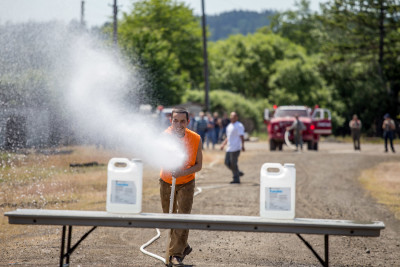
At a contractor fire training in Willamina, crews geared up for the coming fire season while competing to put out mock fires.
Wildfires started by workers and the equipment they operate in the forests and on farms pales in comparison to wildfires started at home and through recreation. In fact, less than a quarter of last year’s human-caused wildfires were started on the job. Many landowners host annual training events to help contract loggers and others get prepared for operating during fire season through equipment inspection, drills, and an overview of best practices. At a training event earlier this month, Allan Foutch, forest manager for Miami Corporation, addressed a crowd of loggers and trained fire-fighters. “This is where you live and the goal is to protect it and prevent fires in your own backyard,” Foutch said. “If there were a fire, you are the people we’d rely on to put it out. We don’t want to have to respond to a fire, but if we do, we need to know when to attack and when to retreat, and how to use our equipment quickly and efficiently so everyone is safe.”
In addition to reviewing fundamentals, the training offered an opportunity to talk about lessons from last year’s fire season. David Hampton, forester and owner of Hampton Affiliates, shared stories from the Willamina Creek Fire that occurred on Hampton, BLM and Hancock land last summer. Hampton noted that it’s not always as straight forward as, “putting the wet stuff on the red stuff” because logistics often get in the way. Access to the Willamina Creek fire was limited by a one-lane road and responders got bottlenecked trying to get fire trucks to the fire before proper traffic control was in place. Hampton also stressed taking time to get familiar with the landscape. “You have to assess what the fire is doing first,” Hampton said. “Safety is key. So are headlamps, though, you can’t see anything in the dark.”
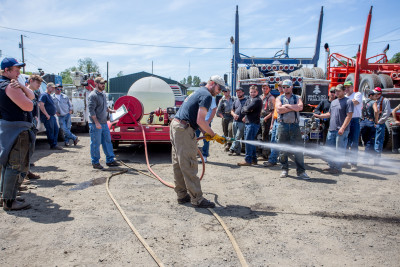
Oregon Department of Forestry tests for adequate water pressure on contractor fire trucks in anticipation of the coming fire season.
Oregon Department of Forestry was also on hand for courtesy fire truck inspections and to stress that recent years have seen earlier and more severe fire seasons. “I’ve been doing this for 22 years,” said Jason Rayburn, Wildland Fire Supervisor, “and it keeps getting worse and worse.” He said fire season used to start after Fourth of July and would start at low to moderate danger, and only get to high danger in August. Last year the fire season started off early in high danger, before the crews even came on board, and saw ten days of extreme danger. “That was off the charts and was a first in my career,” Rayburn said, “we have to up our game.”
The training wrapped up with hose and nozzle competitions, offering about $1,500 in cash prizes for winners who could quickly and properly operate their equipment under pressure. Foutch explained it was more than just a chance to shine, though. “It’s a real-time demonstration of what can go wrong if your hose isn’t rolled properly and your adrenaline is pumping.” All those who participated got a chance to re-roll their hoses under the watchful eye of experts so they’ll be prepared for the real deal.
“We’re here, and we’re ready to go,” said Hampton.
